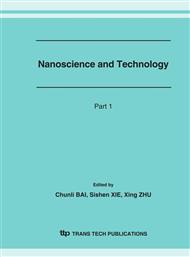p.657
p.661
p.665
p.669
p.673
p.677
p.681
p.685
p.689
Heat-Transfer Mechanism of Sample-Probe in Variable-Temperature Scanning Probe Microscope and Influence of Temperature on Tunneling Current
Abstract:
The macroscopical breakage and nature change of material usually originate in nanometer scale, and the nature of some materials depends on temperature strongly. So it is extremely important for the research of heat transfer in micro-scale and nanometer technology to understand and control the influence of temperature on the nature of material, and developing advanced measuring technique can also improve our knowledge on theories involved in such problem. Due to the usage of variable-temperature sample stage, utilizable range of temperature is widely extended, and thus topography images of materials changing with temperature can be observed so that the thermal properties of materials can be studied further. Accordingly, the theoretical basis of heat-transfer and the influence of temperature on tunneling current owing to temperature variation should be presented. In the view of microscale heat-transfer, this paper describes the problem that heat current transfers from surface of sample to tip of probe through layer of air by means of Boltzmann theory, which can be expressed by the hyperbolic equation of heat conduction when the time is nearly equivalent to slack time and the scale is much larger than the characteristic scale of local thermodynamic equilibrium. The mode of heat-transfer on probe is also analyzed and the analytical solution is obtained in the paper. In addition, the influence of temperature increment of sample on tunneling current is discussed in detail and the change trend of tunneling current with temperature is also obtained in a limited temperature range. Due to such factors, which are possible to disturb the topography images of sample, there is no doubt that many difficulties will be brought to developing new technology such as detecting displacement and strain of materials at microscale by using the images of sample heated and unheated. To understand and control such factors has important advantage for making progress in the advanced scientific fields.
Info:
Periodical:
Pages:
673-676
Citation:
Online since:
March 2007
Authors:
Price:
Сopyright:
© 2007 Trans Tech Publications Ltd. All Rights Reserved
Share:
Citation:


